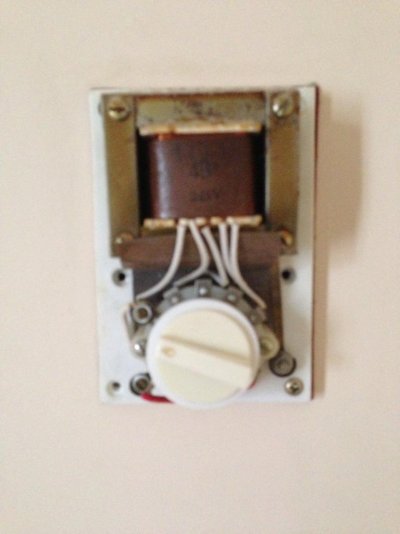I am not an electrician but I have replaced ceiling fans before and never had a problem, until today.
I am replacing a ceiling fan/light on the 2nd floor in my 1965 house. The old fan/light appeared to be original and it had a strange fan speed control box mounted on the wall that had what looked like a transformer block wired to the speed knob. There was no wall switch for the light, you had to use the pull cord.
My plan was to install a new fan/light, install a wall on/off switch where the speed control used to be, and put both the fan and lights on one circuit (so the wall switch could turn the entire system off, not just the fan).
I bought a new Hunter ceiling fan/light (~$100) and installed it. It came with a wireless remote for speed/light but I didn't want that so didn't wire it in. I directly connected the black house wire (hot) to the black fan wire and the striped light wire, and then connected the white fan wire to the white house wire.
I turned the breaker on and went back to the fan. The fan works. The lights work. Literally a minute after I turned it on, one of the 14W CFLs that came with the fan pops and goes dead. 2 minutes later, another one pops. I figure they were cheap and maybe got banged around in transit so got some other CFLs from other fans in my house and put them in. Within 5 minutes 3 more CFLs popped and went dead.
I thought maybe the fan needed the remote control box installed between the house power and the fan/lights, so I wired it in per the instructions. When I turned the power on, the remote control box popped and the side where the wires is turned black. Nothing on the fan works. Time to reassess.
Clearly something is very wrong here. I have multiple other (newer) ceiling fan/lights in my house and they work fine. Some have CFLs, others have incandescents. Could this particular line be wired for more than 120V? Is there a reason the fan and lights need to be on a separate circuit (I think they're all 10A)? I don't have a multimeter but need to get one. I already threw the old fan and speed control away so can't check them for details.
I am replacing a ceiling fan/light on the 2nd floor in my 1965 house. The old fan/light appeared to be original and it had a strange fan speed control box mounted on the wall that had what looked like a transformer block wired to the speed knob. There was no wall switch for the light, you had to use the pull cord.
My plan was to install a new fan/light, install a wall on/off switch where the speed control used to be, and put both the fan and lights on one circuit (so the wall switch could turn the entire system off, not just the fan).
I bought a new Hunter ceiling fan/light (~$100) and installed it. It came with a wireless remote for speed/light but I didn't want that so didn't wire it in. I directly connected the black house wire (hot) to the black fan wire and the striped light wire, and then connected the white fan wire to the white house wire.
I turned the breaker on and went back to the fan. The fan works. The lights work. Literally a minute after I turned it on, one of the 14W CFLs that came with the fan pops and goes dead. 2 minutes later, another one pops. I figure they were cheap and maybe got banged around in transit so got some other CFLs from other fans in my house and put them in. Within 5 minutes 3 more CFLs popped and went dead.
I thought maybe the fan needed the remote control box installed between the house power and the fan/lights, so I wired it in per the instructions. When I turned the power on, the remote control box popped and the side where the wires is turned black. Nothing on the fan works. Time to reassess.
Clearly something is very wrong here. I have multiple other (newer) ceiling fan/lights in my house and they work fine. Some have CFLs, others have incandescents. Could this particular line be wired for more than 120V? Is there a reason the fan and lights need to be on a separate circuit (I think they're all 10A)? I don't have a multimeter but need to get one. I already threw the old fan and speed control away so can't check them for details.


